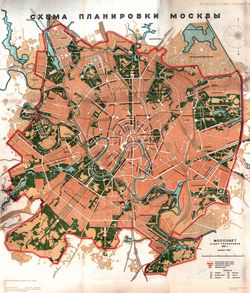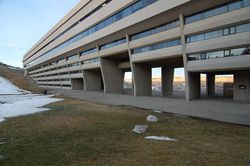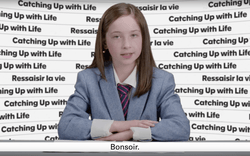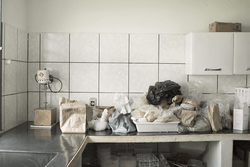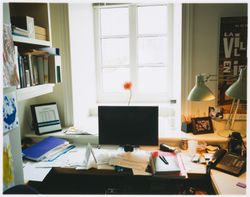Pedro Ignacio Alonso, CCA Visiting Scholar, professor at the Universidad Católica de Chile and Visiting Tutor at the Architectural Association, London, presents the process of donation and installation of Soviet concrete panel factories in Fidel Castro’s Cuba and Salvador Allende’s Chile during the Cold War. Click here for the Facebook event.
Shaughnessy House
26 May 2011 , 6PM
Visiting Scholar Seminar: Pedro Ignacio Alonso
Actions:
Description:
Pedro Ignacio Alonso, CCA Visiting Scholar, professor at the Universidad Católica de Chile and Visiting Tutor at the Architectural Association, London, presents the process of donation and installation of Soviet concrete panel factories in Fidel Castro’s Cuba and Salvador Allende’s Chile during the Cold War. Click here for the Facebook event.
Shaughnessy House
Sub-series
AP116.S3.SS20
Description:
Sub-series documents the planning and production of Public Fear: What's So Scary About Architecture?, issue 18 of ANY magazine (May) and its accompanying In ANY Event Symposium, held January 25, 1997 at the Guggenheim Museum, New York City, New York. Sub-series is arranged into seven files, by object type. Material in sub-series was produced between 1996 and 1997. Sub-series contains drafts, research materials, documents relating to publicity, articles, illustrations and photographs, mock-ups, videocassettes and audiocassettes of symposium and copies of the issue.
1996-1997
Public Fear: What's So Scary About Architecture?
Actions:
AP116.S3.SS20
Description:
Sub-series documents the planning and production of Public Fear: What's So Scary About Architecture?, issue 18 of ANY magazine (May) and its accompanying In ANY Event Symposium, held January 25, 1997 at the Guggenheim Museum, New York City, New York. Sub-series is arranged into seven files, by object type. Material in sub-series was produced between 1996 and 1997. Sub-series contains drafts, research materials, documents relating to publicity, articles, illustrations and photographs, mock-ups, videocassettes and audiocassettes of symposium and copies of the issue.
Sub-series 20
1996-1997
Project
AP148.S1.1970.PR02
Description:
The project series documents Poli's work on the Interplanetary Architecture project, which was also made into a film by Superstudio directed by Alessandro Poli (the film is not included in the fonds). The project reflects Poli's deep fascination with the moon landing in 1969. Poli uses this major media event as a catalyst for thinking about a new approach to architecture and tools for design, including the idea that film and the movie camera should become part of the toolset. The project also seems to be in some way a response to Epoch magazine's challenge for a "Primo concorso di architettura nello spazio" (the first architectural competition in space), and includes much imagery and textual references to a new road or architectural links between the earth and other planets, including an earth moon highway. In his storyboard, Poli also makes reference to his earlier Piper project, and some imagery features wheels and an amusement park. The Interplanetary Architecture project was exhibited by Superstudio in Rome in 1972 and featured in "Casabella" magazine in April 1972 (no. 364). The project was also featured in the 2010 CCA exhibition "Other Space Odysseys". In the accompanying CCA publication, Poli describes this project as "a voyage off earthbound routes in quest of architecture unfettered by the urban nightmare, by induced needs or by planning as the only tool for regulating and solving the world's problems" (Poli quoted in Borasi and Zardini, 2010, 110). Poli's work on this project is deeply tied to the Zeno project, which was also featured in this exhibition and is included in this fonds (see AP148.S1.1972.PR01). For the Zeno project, Poli envisioned a dialogue between astronaut Buzz Aldrin and an Italian peasant, Zeno of Riparbella. Poli felt that these two shared a similarity in that both their homes were isolated capsules, one that provided a lens from which to see the rest of the world and understand their place in it. The material in the series includes numerous photomontages and collages of astronauts in space, as well as drawings of plantery shapes and structures. There are also texts, some of which include calculations of distances and diameters of planets, as well as notebooks and sketchbooks, many of which Poli included in a folder he entitled "Storyboard." The series also includes an unsent letter from Poli to Adolfo Natalini which describes how, after the moon landing, everything - the planet, the moon, the stars - is architecture, and that this will necessitate the need for new design tools, such as the movie camera. Some works are signed Alessandro Poli-Superstudio. Source cited: Giovanna Borasi and Mirko Zardini, eds., Other Space Odysseys, Montreal and Baden: Canadian Centre for Architecture/Lars Müller Publishers, 2010.
1969-1971
Architettura Interplanetaria [Interplanetary Architecture] (1970-1971)
Actions:
AP148.S1.1970.PR02
Description:
The project series documents Poli's work on the Interplanetary Architecture project, which was also made into a film by Superstudio directed by Alessandro Poli (the film is not included in the fonds). The project reflects Poli's deep fascination with the moon landing in 1969. Poli uses this major media event as a catalyst for thinking about a new approach to architecture and tools for design, including the idea that film and the movie camera should become part of the toolset. The project also seems to be in some way a response to Epoch magazine's challenge for a "Primo concorso di architettura nello spazio" (the first architectural competition in space), and includes much imagery and textual references to a new road or architectural links between the earth and other planets, including an earth moon highway. In his storyboard, Poli also makes reference to his earlier Piper project, and some imagery features wheels and an amusement park. The Interplanetary Architecture project was exhibited by Superstudio in Rome in 1972 and featured in "Casabella" magazine in April 1972 (no. 364). The project was also featured in the 2010 CCA exhibition "Other Space Odysseys". In the accompanying CCA publication, Poli describes this project as "a voyage off earthbound routes in quest of architecture unfettered by the urban nightmare, by induced needs or by planning as the only tool for regulating and solving the world's problems" (Poli quoted in Borasi and Zardini, 2010, 110). Poli's work on this project is deeply tied to the Zeno project, which was also featured in this exhibition and is included in this fonds (see AP148.S1.1972.PR01). For the Zeno project, Poli envisioned a dialogue between astronaut Buzz Aldrin and an Italian peasant, Zeno of Riparbella. Poli felt that these two shared a similarity in that both their homes were isolated capsules, one that provided a lens from which to see the rest of the world and understand their place in it. The material in the series includes numerous photomontages and collages of astronauts in space, as well as drawings of plantery shapes and structures. There are also texts, some of which include calculations of distances and diameters of planets, as well as notebooks and sketchbooks, many of which Poli included in a folder he entitled "Storyboard." The series also includes an unsent letter from Poli to Adolfo Natalini which describes how, after the moon landing, everything - the planet, the moon, the stars - is architecture, and that this will necessitate the need for new design tools, such as the movie camera. Some works are signed Alessandro Poli-Superstudio. Source cited: Giovanna Borasi and Mirko Zardini, eds., Other Space Odysseys, Montreal and Baden: Canadian Centre for Architecture/Lars Müller Publishers, 2010.
Project
1969-1971
Join us tonight, 9 June 2011 at 6 pm in the Shaughnessy House. Visiting Scholar Elisabeth Essaïan presents her research on urban planning during the Stalin era, and a critical assessment of the reception it received in European and North American publications from the 1920s to 1950s. Presented in French. Click here for the Facebook event. Consult the summer seminar(...)
Shaughnessy House
9 June 2011 , 6pm
Visiting Scholar Seminar: Elisabeth Essaïan
Actions:
Description:
Join us tonight, 9 June 2011 at 6 pm in the Shaughnessy House. Visiting Scholar Elisabeth Essaïan presents her research on urban planning during the Stalin era, and a critical assessment of the reception it received in European and North American publications from the 1920s to 1950s. Presented in French. Click here for the Facebook event. Consult the summer seminar(...)
Shaughnessy House
Michelangelo Sabatino, 2011 Visiting Scholar, offers an overview of Arthur Erickson’s contribution to shaping the city of the 20th century, drawn from his forthcoming book Arthur Erickson : Architectural Environments. Click here for the Facebook event.
Shaughnessy House
Presented in English Keyword(s):
Michelangelo Sabatino, visiting scholar seminar
11 August 2011, 6pm
Visiting Scholar Seminar: Michelangelo Sabatino
Actions:
Description:
Michelangelo Sabatino, 2011 Visiting Scholar, offers an overview of Arthur Erickson’s contribution to shaping the city of the 20th century, drawn from his forthcoming book Arthur Erickson : Architectural Environments. Click here for the Facebook event.
Shaughnessy House
Presented in English Keyword(s):
Michelangelo Sabatino, visiting scholar seminar
Project
Colina artificial, International Architecture Biennale Rotterdam, Leeuwarden, Netherlands (2005)
AP164.S1.2005.D3
Description:
The project series documents the design for an artificial hill and serves as the finish-line for the “Elfstedentocht”, Leeuwarden, Netherlands, at the International Architecture Biennale Rotterdam 2005. The firm identified this project as number 201. "The finish of the great race of the Elfstedentocht should be accompanied by a three-dimensial event which signals the site in the memory of the citizen. If from there, furthermore, the last part of the race is dominated we will be able to imagine that this three-dimensional event is a hybrid between a tribune and a landscaping milestone. […] If towards the South and East it disposes of a slope consisting of artificial lawn with solarium and tribunes above the canal and a scating [sic] park, then towards the North it could house the sport installations with tribunes and a climbing zone with the result that this minimum architectural organization could give life to the site during all year basing on the small sports center, solarium and skating track. A shelter structure crowns the artificial hill composing a lookout spot from where one dominates the whole city and the surrounding landscape." (ARCH270975) Documenting the project are conceptual and presentation drawings, digital, graphic and reference materials, correspondence, publications, competition documents, and agreements.
1982, 2005, predominant 2005
Colina artificial, International Architecture Biennale Rotterdam, Leeuwarden, Netherlands (2005)
Actions:
AP164.S1.2005.D3
Description:
The project series documents the design for an artificial hill and serves as the finish-line for the “Elfstedentocht”, Leeuwarden, Netherlands, at the International Architecture Biennale Rotterdam 2005. The firm identified this project as number 201. "The finish of the great race of the Elfstedentocht should be accompanied by a three-dimensial event which signals the site in the memory of the citizen. If from there, furthermore, the last part of the race is dominated we will be able to imagine that this three-dimensional event is a hybrid between a tribune and a landscaping milestone. […] If towards the South and East it disposes of a slope consisting of artificial lawn with solarium and tribunes above the canal and a scating [sic] park, then towards the North it could house the sport installations with tribunes and a climbing zone with the result that this minimum architectural organization could give life to the site during all year basing on the small sports center, solarium and skating track. A shelter structure crowns the artificial hill composing a lookout spot from where one dominates the whole city and the surrounding landscape." (ARCH270975) Documenting the project are conceptual and presentation drawings, digital, graphic and reference materials, correspondence, publications, competition documents, and agreements.
Project
1982, 2005, predominant 2005
articles
What, if not the family?
A Social Reset
Soirée, gala, family, what if not the family?, Miranda July, Other Architects, Grace Mortlock, David Neustein, Elena Schütz, Julian Schubert, Leonard Streich, Something Fantastic, Edit Collective, Marisa Morán Jahn, Rafi Segal, Carehaus, Johanna Hurme, 5468796 Architecture, Nahira Gerster-Sim, Frida Escobedo, Kumiko Inui, Emanuel Admasu, AD-WO
7 June 2021
What, if not the family?
Guests from multidisciplinary perspectives discuss the spatial implications of ongoing shifts in ideas of the family
Actions:
A Social Reset
As the Earth’s climate reaches a state of constant instability, there is growing awareness of how global warming can affect human rights and increase social strife. Less attention has been paid to the ways in which political violence and human rights abuses, from past and present, constitute driving factors in the transformations of the global environment and climate.(...)
Paul Demarais Theatre
1 December 2016, 6pm
In the Frontiers of Climate Change (Toward a Politics of Nonhuman Rights)
Actions:
Description:
As the Earth’s climate reaches a state of constant instability, there is growing awareness of how global warming can affect human rights and increase social strife. Less attention has been paid to the ways in which political violence and human rights abuses, from past and present, constitute driving factors in the transformations of the global environment and climate.(...)
Paul Demarais Theatre
When the Canadian Centre for Architecture building was conceived and designed as an addition to the nineteenth-century Shaughnessy House, it also became an addition to the CCA’s extensive collection. Accordingly, the inaugural exhibitions in the new building in 1989 included a display on the Building and Gardens. The CCA, which plays an influential role in furthering(...)
Hall cases
22 April 2015 to 30 November 2015
The CCA in Photographs, 1987–2015
Actions:
Description:
When the Canadian Centre for Architecture building was conceived and designed as an addition to the nineteenth-century Shaughnessy House, it also became an addition to the CCA’s extensive collection. Accordingly, the inaugural exhibitions in the new building in 1989 included a display on the Building and Gardens. The CCA, which plays an influential role in furthering(...)
Hall cases
archives
Level of archival description:
Collection
CD034
Synopsis:
The SAAL Process exhibition collection consists of reproductions of several objects used in the exhibition “The SAAL Process, Housing in Portugal 1974–76.” It was created by the Museu Serralves and travelled to the Canadian Center for Architecture (CCA) in 2015. The collection contains reproductions of drawings, presentation panels and photographs dating from 1974 to 1979. Born out of the Portuguese Revolution of 25 April 1974, the Serviço Ambulatório de Apoio Local (Local Ambulatory Support Service) was a pioneering architectural and political experiment designed to address extreme housing shortages and poor living conditions in Portuguese cities.
1974-1979
The SAAL Process exhibition collection
Actions:
CD034
Synopsis:
The SAAL Process exhibition collection consists of reproductions of several objects used in the exhibition “The SAAL Process, Housing in Portugal 1974–76.” It was created by the Museu Serralves and travelled to the Canadian Center for Architecture (CCA) in 2015. The collection contains reproductions of drawings, presentation panels and photographs dating from 1974 to 1979. Born out of the Portuguese Revolution of 25 April 1974, the Serviço Ambulatório de Apoio Local (Local Ambulatory Support Service) was a pioneering architectural and political experiment designed to address extreme housing shortages and poor living conditions in Portuguese cities.
archives
Level of archival description:
collection
1974-1979

